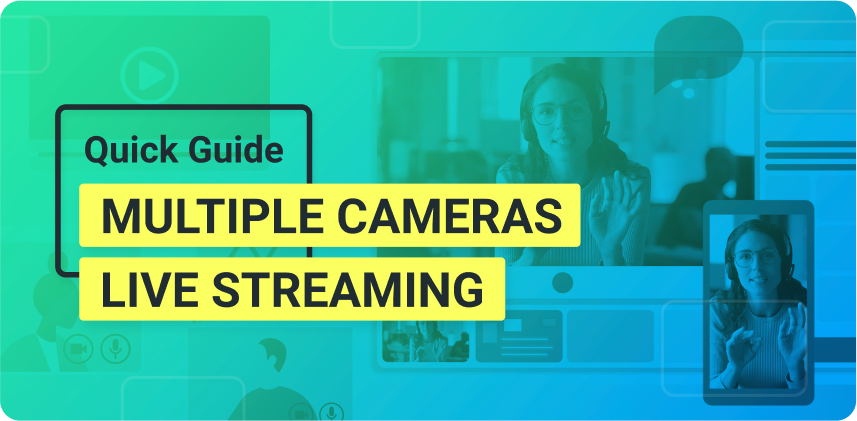Putting the following live streaming best practices into action, before your next broadcast, can help you increase viewership and boost your results.
Live video can be one of the most cost-effective marketing tools for businesses. The entry cost is low compared to other video endeavors, and the heightened engagement helps build relationships that lead to sales. It’s crucial for your business to apply the following live streaming best practices to harness these benefits and many more.
Through live streaming, your business has the opportunity to:
- Reach more people online
- Generate more leads
- Build relationships with potential customers
- Create content on a budget
If you want more live video tools to use during live streams, get ManyCam today!
11 Live streaming best practices for your business
Interact with viewers
One of the most important live streaming best practices is to interact with your viewers as much as possible without losing track of your topic. Interaction is paramount in live video. Unlike videos on-demand, viewers join live streams worldwide to participate instead of watching passively. That’s why live videos can create such compelling and captivating content.
Real-time interaction can be a game-changer for your business. Apart from building trust, you’ll get to know your audience better and understand their needs. Once you know more about their needs, your marketing efforts and products can be refined for optimal results.
Test your equipment
When it comes to live streaming best practices, handling your live video equipment is a must. Live stream audiences indeed tend to be more forgiving regarding technical malfunctions and some streaming mishaps. But minimizing live streaming mistakes is vital to send viewers the right message about your company.
Not only should you test all your live stream gear, but you should also do a recorded dry run of your entire live video, which is easier than it sounds. Streaming platforms allow you to go live in private so you can rehearse your live stream and play it back to make sure everything works well.
Go in with a plan
Among live streaming best practices, this one is continuously overlooked. Many streamers go live without an outlined plan hoping they can just wing it, but, more often than not, they can’t, which leads to a lot of “eh”s and “um…”s.
You don’t need to write an entire script for your live stream, but a proper outline with the topics you want to talk about will help keep you on track throughout the broadcast. When planning your live stream, consider what your goal is so that you can maximize your results.
Have a clear call to action
On that note, with your outline and goal in mind, it’s a live streaming best practice to have a clear call to action during the stream and at the end. Without a call to action, you could be missing out on potential returns. It can be something as simple as “sign up to our newsletter” or “send us a tweet with your takeaway from this live session.”
Whether your goal is to strengthen relationships or spread the word about your business, the call to action should be aligned with it to increase your positive results.
Promote your live streaming in advance
As you probably noticed, applying live streaming best practices during your live videos is only part of the equation. Much of the live streaming work is done before you actually go live. One of the most crucial steps to stream successfully is promoting your live streams beforehand.
When you schedule your live video, it’s important to let people know in advance so they can prepare themselves and share it with friends. Ideally, you would have a landing page for them to sign up to the live stream so they can be notified when you go live.
Make time for Q&A
A fantastic way to boost engagement and interaction is through questions and answers. Whenever you plan a live stream, make sure to leave some time for Q&A. Not only is this effective as a live streaming best practice, but it also helps you enrich your content.
Your audience’s questions will tell you a lot about them and can help you navigate your content creation strategy. For instance, questions that come up too often can become a live streaming topic on its own and eventually originate new products or services.
Create a consistent schedule
Regarding live streaming best practices, consistency is a vital one. You’ve heard it before, and you’ll probably hear it again, and again, being consistent is essential to content marketing. This concept still holds water.
Live streaming on a consistent schedule can help you increase viewership and build trust among your followers if your content brings them value.
Encourage your audience to share
A great way to expand your online reach with live streaming is by encouraging your audience to share the content. Most viewers won’t, but there are always die-hard fans eager to help that could share your live stream and get you more viewers.
Some content creators offer incentives to their audience, such as contests and giveaways that prompt them to share. It can work depending on your offer and speed your growth but, in the long run, it’s not a required best practice to live streaming successfully.
Get someone to help you
Among live streaming best practices, this one is not talked about nearly as enough as it should. Live streaming involves many technical aspects, along with the challenges of interacting with a “live” audience. Having someone to help share these responsibilities can make a huge difference in your results.
When your live streaming, you can choose to have a co-host presenting the content with you and interacting with viewers or have someone behind the curtains operating the equipment and monitoring the feed.
Comply with the platform’s rules
As far as live streaming best practices go, complying with your preferred streaming platform is one that cannot be overlooked. Each platform has its own streaming guides and rules. For example, Facebook is very vigilant when it comes to audio copyrights, and they have taken down many live streams for playing songs in the background.
Before you go live, remember to check the policies of your chosen streaming platform to ensure your stream stays live.
Have fun while streaming
If you want to disregard all the previous live streaming best practices, you can but keep this one in mind, have fun while streaming. Going live can be a bit scary, but when your audience sees that you are happy to be there and, most importantly, that you are trying your best, they will get on board.
Live streaming as a business is about showing that your company has personality and creating real connections with viewers. When you have fun during your broadcasts, you’ll get some fans for life.
Key Takeaway
With these live streaming best practices in place, your broadcast will be smoother, and the chances of you achieving the results you’re after are much higher. It may seem like a lot to take in at first, so we suggest trying to take action on a few of these recommendations at a time. Soon enough, you’ll be live streaming like a pro and bringing in new potential customers.
Want to enhance your live stream? Download ManyCam for free!
Want to learn more about live streaming?
Your Essential Guide to Live Streaming Software
Live streaming videos can be captivating when you have the right tools. This live streaming software guide can help you live stream like a pro. (Continue reading)
What Do You Need To Live Stream?
Many people think lots of equipment and a big budget is what you need to live stream like a pro. But is that true? (Continue reading)






